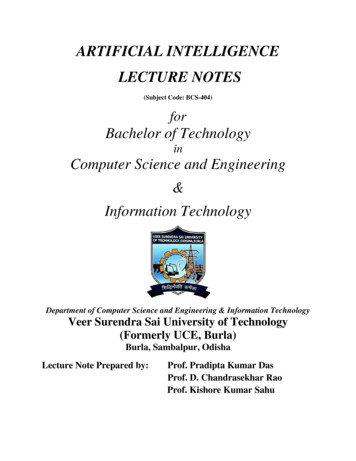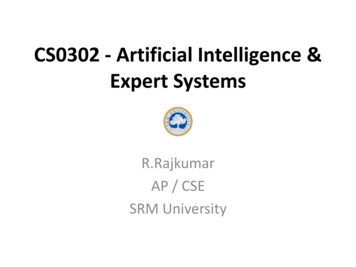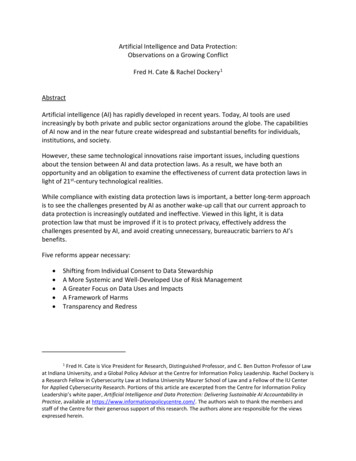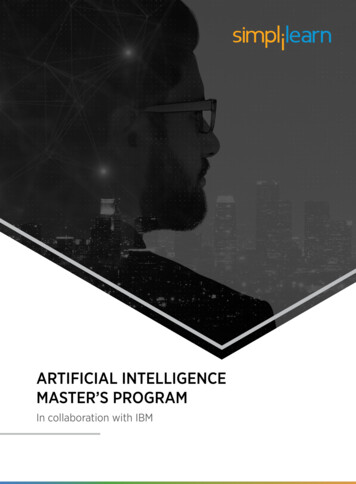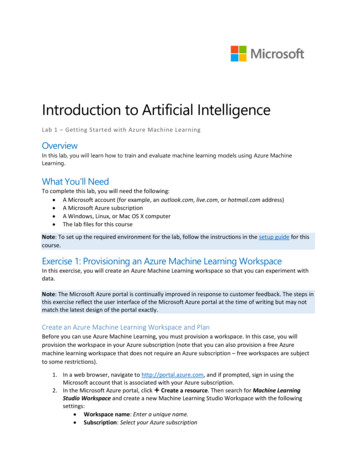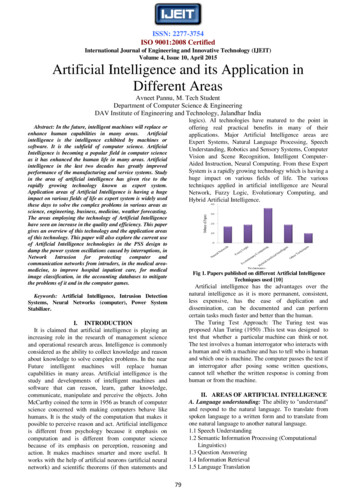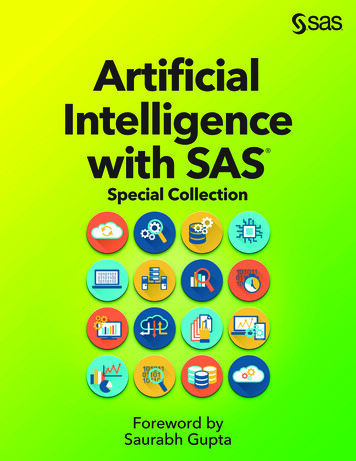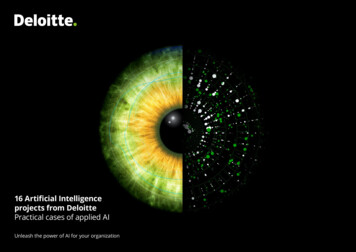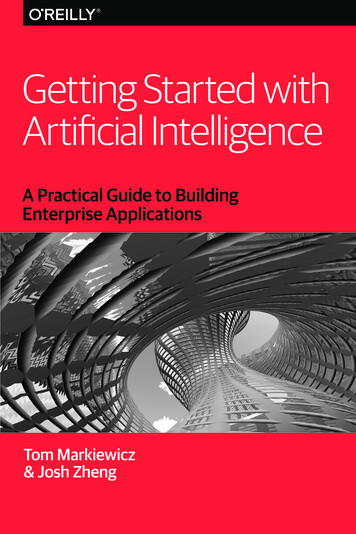
Transcription
Getting Started withArtificial IntelligenceA Practical Guide to BuildingEnterprise ApplicationsTom Markiewicz& Josh Zheng
Getting Started with ArtificialIntelligenceA Practical Guide to BuildingEnterprise ApplicationsTom Markiewicz and Josh ZhengBeijingBoston Farnham SebastopolTokyo
Getting Started with Artificial Intelligenceby Tom Markiewicz and Josh ZhengCopyright 2018 International Business Machines Corporation. All rights reserved.Printed in the United States of America.Published by O’Reilly Media, Inc., 1005 Gravenstein Highway North, Sebastopol, CA 95472.O’Reilly books may be purchased for educational, business, or sales promotional use. Online edi‐tions are also available for most titles (http://oreilly.com/safari). For more information, contact ourcorporate/institutional sales department: 800-998-9938 or corporate@oreilly.com.Editor: Nicole TacheProduction Editor: Justin BillingCopyeditor: Rachel MonaghanProofreader: Charles RoumeliotisDecember 2017:Interior Designer: David FutatoCover Designer: Karen MontgomeryIllustrator: Rebecca DemarestFirst EditionRevision History for the First Edition2017-12-15:2018-04-13:First ReleaseSecond ReleaseThe O’Reilly logo is a registered trademark of O’Reilly Media, Inc. Getting Started with ArtificialIntelligence, the cover image, and related trade dress are trademarks of O’Reilly Media, Inc.While the publisher and the authors have used good faith efforts to ensure that the information andinstructions contained in this work are accurate, the publisher and the authors disclaim all responsi‐bility for errors or omissions, including without limitation responsibility for damages resulting fromthe use of or reliance on this work. Use of the information and instructions contained in this work isat your own risk. If any code samples or other technology this work contains or describes is subjectto open source licenses or the intellectual property rights of others, it is your responsibility to ensurethat your use thereof complies with such licenses and/or rights.This work is part of a collaboration between O’Reilly and IBM. See our statement of editorial inde‐pendence.978-1-492-02779-9[LSI]
Table of Contents1. Introduction to Artificial Intelligence. . . . . . . . . . . . . . . . . . . . . . . . . . . . . . . . . . . . . . . 1The Market for Artificial IntelligenceAvoiding an AI WinterArtificial Intelligence, Defined?Applications in the EnterpriseNext Steps223672. Natural Language Processing. . . . . . . . . . . . . . . . . . . . . . . . . . . . . . . . . . . . . . . . . . . . . 9Overview of NLPThe Components of NLPEnterprise Applications of NLPHow to Use NLPChallenges of NLPSummary1011121517173. Chatbots. . . . . . . . . . . . . . . . . . . . . . . . . . . . . . . . . . . . . . . . . . . . . . . . . . . . . . . . . . . . . . 19What Is a Chatbot?The Rise of ChatbotsHow to Build a ChatbotChallenges of Building a Successful ChatbotBest PracticesIndustry Case StudiesSummary192021282834354. Computer Vision. . . . . . . . . . . . . . . . . . . . . . . . . . . . . . . . . . . . . . . . . . . . . . . . . . . . . . . 37Capabilities of Computer Vision for the EnterpriseHow to Use Computer VisionComputer Vision on Mobile DevicesBest Practices38414243iii
Use CasesExisting Challenges in Computer VisionImplementing a Computer Vision SolutionSummary454748485. AI Data Pipeline. . . . . . . . . . . . . . . . . . . . . . . . . . . . . . . . . . . . . . . . . . . . . . . . . . . . . . . . 49Preparing for a Data PipelineSourcing Big DataStorage: Apache HadoopHadoop as a Data LakeDiscovery: Apache SparkSummary5151525253546. Looking Forward. . . . . . . . . . . . . . . . . . . . . . . . . . . . . . . . . . . . . . . . . . . . . . . . . . . . . . . 55What Makes Enterprises Unique?Current Challenges, Trends, and OpportunitiesScalabilitySocial ImplicationsSummaryiv Table of Contents5657606061
CHAPTER 1Introduction to Artificial IntelligenceIn the future AI will be diffused into every aspect of the economy.—Nils J. Nilsson, Founding researcher, Artificial Intelligence & Computer Sci‐ence, Stanford UniversityBeyond the buzzwords, media coverage, and hype, artificial intelligence techni‐ques are becoming a fundamental component of business growth across a widerange of industries. And while the various terms (algorithms, transfer learning,deep learning, neural networks, NLP, etc.) associated with AI are thrown aroundin meetings and product planning sessions, it’s easy to be skeptical of the poten‐tial impact of these technologies.Today’s media represents AI in many ways, both good and bad—from the fear ofmachines taking over all human jobs and portrayals of evil AIs via Hollywood tothe much-lauded potential of curing cancer and making our lives easier. Ofcourse, the truth is somewhere in between.While there are obviously valid concerns about how the future of artificial intelli‐gence will play out (and the social implications), the reality is that the technologyis currently used in companies across all industries.AI is used everywhere—IoT (Internet of Things) and home devices, commercialand industrial robots, autonomous vehicles, drones, digital assistants, and evenwearables. And that’s just the start. AI will drive future user experiences that areimmersive, continuous, ambient, and conversational. These conversational serv‐ices (e.g., chatbots and virtual agents) are currently exploding, while AI will con‐tinue to improve these contextual experiences.Despite several stumbles over the past 60–70 years of effort on developing artifi‐cial intelligence, the future is here. If your business is not incorporating at leastsome AI, you’ll quickly find you’re at a competitive disadvantage in today’s rap‐idly evolving market.1
Just what are these enterprises doing with AI? How are they ensuring an AIimplementation is successful (and provides a positive return on investment)?These are only a few of the questions we’ll address in this book. From naturallanguage understanding to computer vision, this book will provide you a highlevel introduction to the tools and techniques to better understand the AI land‐scape in the enterprise and initial steps on how to get started with AI in your owncompany.It used to be that AI was quite expensive, and a luxury reserved for specificindustries. Now it’s accessible for everyone in every industry, including you. We’llcover the modern enterprise-level AI techniques available that allow you to bothcreate models efficiently and implement them into your environment. While notmeant as an in-depth technical guide, the book is intended as a starting point foryour journey into learning more and building applications that implement AI.The Market for Artificial IntelligenceThe market for artificial intelligence is already large and growing rapidly, withnumerous research reports indicating a growing demand for tools that automate,predict, and quickly analyze. Estimates from IDC predict revenue from artificialintelligence will top 47 billion by the year 2020 with a compound annual growthrate (CAGR) of 55.1% over the forecast period, with nearly half of that going tosoftware. Additionally, investment in AI and machine learning companies hasincreased dramatically—AI startups have raised close to 10 billion in funding.Clearly, the future of artificial intelligence appears healthy.Avoiding an AI WinterModern AI as we know it started in earnest in the 1950s. While it’s not necessaryto understand the detailed history of AI, it is helpful to understand one particularconcept—the AI winter—as it shapes the current environment.There were two primary eras of artificial intelligence research where high levelsof excitement and enthusiasm for the technology never lived up to expectations,causing funding, interest, and continued development to dry up. The buildup ofhype followed by disappointment is the definition of an AI winter.So why are we now seeing a resurgence in AI interest? What’s the differencetoday that’s making AI so popular in the enterprise, and should we fear anotherAI winter? The short answer is likely no—we expect to avoid another AI winterthis time around due primarily to much more (or big) data and the advent of bet‐ter processing power and GPUs. From the tiny supercomputers we all carry inour pockets to the ever-expanding role of IoT, we’re generating more data now, atan ever-increasing rate. For example, IDC estimates that 180 zettabytes of datawill be created globally in 2025, up from less than 10 zettabytes in 2015.2 Chapter 1: Introduction to Artificial Intelligence
Andrew Ng, cofounder of Coursera and Stanford adjunct professor, oftenpresents Figure 1-1 in his courses on machine learning and deep learning.Figure 1-1. Deep learning performance (image courtesy of Andrew Ng, Deeplearn‐ing.ai course on Coursera)Conceptually, this chart illustrates how the performance of deep learning algo‐rithms improves with an increasing amount of data—data that we now have inabundance and that is growing at an exponential rate.So why does it matter whether we understand the AI winter? Well, if companiesare going to invest in AI, it’s essential to avoid the hyperbole of the past and keepexpectations based in reality. While the current situation is much more likely tojustify the enthusiasm, that excitement still needs to be tempered with real-worldresults to avoid another AI winter. As (future) AI practitioners, that’s somethingwe can all agree would challenge your businesses.Artificial Intelligence, Defined?The market for artificial intelligence is immense, but what are we truly discus‐sing? While it sounds great to say you’re going to implement AI in your business,just what does that mean in practical terms? Artificial intelligence is quite a broadterm and is, in reality, an umbrella over a few different concepts.So, to get started and keep everyone on the same page, let’s briefly discuss someof the terms associated with AI that are often confused or interchanged: artificialintelligence, machine learning, and deep learning.Artificial Intelligence, Defined? 3
Artificial IntelligenceOver the years, there have been numerous attempts at precisely defining AI.While there’s never really been an official, accepted definition, there are a fewhigh-level concepts that shape and define what we mean. The descriptions rangefrom artificial intelligence merely aiming to augment human intelligence tothinking machines and true computer intelligence. For our purposes, we canthink of AI as being any technique that allows computers to bring meaning todata in similar ways to a human.While most AI is focused on specific problem domains (natural language pro‐cessing or computer vision, for example), the idea of artificial general intelli‐gence or having a machine perform any task a human could (also commonlyreferred to as “strong AI”) is still more than 10 years out according to Gartner.Machine LearningIn 1959 Arthur L. Samuel, an IBM researcher and Stanford professor, is said tohave stated that “machine learning is the field of study that gives computers theability to learn without being explicitly programmed,” thereby becoming theoriginator of the term.Essentially, machine learning is a subset of AI focused on having computers pro‐vide insights into problems without explicitly programming them to do so. Mostof the tools and techniques that today refer to AI are representative of machinelearning. There are three main types of machine learning—supervised learning,unsupervised learning, and reinforcement learning.By looking at many labeled data points and examples of historical problems,supervised learning algorithms can help solve similar problems under new cir‐cumstances. Supervised learning trains on large volumes of historical data andthen builds general rules to be applied to future problems. The better the trainingset data, the better the output. In supervised learning, the system learns fromthese human-labeled examples.While supervised learning relies on labeled or structured data (think rows in adatabase), unsupervised learning trains on unlabeled or unstructured data (thetext of a book). These algorithms explore the data and try to find structure. Here,widely used unsupervised learning algorithms are cluster analysis and marketbasket analysis. Naturally, this tends to be more difficult, as the data has no pre‐existing labels to assist the algorithms in understanding the data. While morechallenging to process, as we’ll discuss later, unstructured data makes up the vastmajority of data that enterprises need to process today.Finally, there’s reinforcement learning as a machine learning technique. Rein‐forcement learning takes an approach similar to behavioral psychology. Insteadof training a model with predefined training sets (i.e., where you know the pre‐4 Chapter 1: Introduction to Artificial Intelligence
scribed answers in advance) as in supervised learning, reinforcement learningrewards the algorithm when it performs the correct action (behavior). Reinforce‐ment learning resists providing too much training and allows the algorithm tooptimize itself for performance-based rewards.Reinforcement learning was initially conceived in 1951 by Marvin Minsky, but aswas the case with many AI implementations, the algorithms were held back byboth the scale of data and computer processing power needed for effectiveness.Today, we see many more successful examples of reinforcement learning in thefield, with Alphabet subsidiary DeepMind’s AlphaGo one of the more prominent.Another notable application of reinforcement learning is the development of selfdriving cars.Deep LearningNo book on developing AI applications in the enterprise would be completewithout a discussion of deep learning. One way to understand deep learning is tothink of it as a subset of AI that attempts to develop computer systems that learnusing neural networks like those in the human brain. While machine learning ismostly about optimization, deep learning is more focused on creating algorithmsto simulate how the human brain’s neurons work.Deep learning algorithms are composed of an interconnected web of nodes calledneurons and the edges that join them together. Neural nets receive inputs, per‐form calculations, and then use this output to solve given problems.One of the ultimate goals of AI is to have computers think and learn like humanbeings. Using neural networks that are based on the human brain’s decisionmaking process, deep learning is a set of computational techniques that move usclosest to that goal.According to Stanford professor Chris Manning, around the year 2010 deeplearning techniques started to outperform other machine learning techni‐ques. Shortly after that, in 2012, Geoffrey Hinton at the University of Toronto leda team creating a neural network that learned to recognize images. Additionally,that year Andrew Ng led a team at Google that created a system to recognize catsin YouTube videos without explicitly training it on cats.By building multiple layers of abstraction, deep learning technology can alsosolve complex semantic problems. Traditional AI follows a linear programmingstructure, thus limiting the ability for a computer to learn without human inter‐vention. However, deep learning replaces this existing approach with selflearning and self-teaching algorithms enabling more advanced interpretation ofdata. For example, traditional AI could read a zip code and mailing address off ofan envelope, but deep learning could also infer from the envelope’s color and datesent that the letter contains a holiday card.Artificial Intelligence, Defined? 5
Deep learning’s closer approximation to how the human brain processes infor‐mation via neural networks offers numerous benefits. First, the approach deliversa significantly improved ability to process large volumes of unstructured data,finding meaningful patterns and insights. Next, deep learning offers the ability todevelop models across a wide variety of data, highlighted by advancedapproaches toward text, images, audio, and video content. Finally, deep learning’smassive parallelism allows for the use of multiple processing cores/computers tomaximize overall performance as well as faster training with the advent of GPUs.As with all advances in AI, deep learning benefits from much more training datathan ever before, faster machines and GPUs, and improved algorithms. Theseneural networks are driving rapid advances in speech recognition, image recog‐nition, and machine translation, with some systems performing as well or betterthan humans.Applications in the EnterpriseFrom finance to cybersecurity to manufacturing, there isn’t an industry that willnot be affected by AI. But before we can discuss and examine building applica‐tions in the enterprise with AI, we first need to define what we mean by enter‐prise applications. There are two common definitions of “the enterprise”: A company of significant size and budget Any business-to-business commerce (i.e., not a consumer)So Geico, Procter & Gamble, IBM, and Sprint would all be enterprise companies.And by this definition, any software designed and built internally would be con‐sidered enterprise software. On the other hand, a small company or startup coulddevelop applications to be used by businesses (whether large or small), and thiswould still be considered enterprise software. However, a photo sharing app forthe average consumer would not be considered enterprise software.This is probably obvious, but since we’re discussing enterprise applications withAI in this book, it’s important to be explicit about just what we mean when talk‐ing about the enterprise. For the rest of the book, the context of an enterprise willbe that the end user is a business or business employee.Does that mean if you are building the next great consumer photo sharing appli‐cation that this book will be of no use? Absolutely not! Many (if not most) of theconcepts discussed throughout the book can be directly applied to consumerfacing applications as well. However, the use cases and discussion will be centeredon the enterprise.6 Chapter 1: Introduction to Artificial Intelligence
Next StepsThis book is intended to provide a broad overview of artificial intelligence, thevarious technologies involved, relevant case studies and examples of implementa‐tion, and the current landscape. Also, we’ll discuss the future of AI and where wesee it moving in the enterprise from a current practitioner’s viewpoint.While the book focuses on a more technical audience, specifically applicationdevelopers looking to apply AI in their business, the overall topics and discussionwill be useful for anyone interested in how artificial intelligence will impact theenterprise.Note that this book is not a substitute for a course or deep study on these topics,but we hope the material covered here jump-starts the process of your becominga proficient practitioner of AI technologies.While there are many options for implementing the various AI techniques we’lldiscuss in this book—coding in-house from scratch, outsourcing, the use of opensource libraries, software-as-a-service APIs from leading vendors—our familiar‐ity and deep experience revolves around IBM Watson, so we’ll be using thosecode examples to illustrate the individual topics as necessary.It’s important to note that, while we believe IBM Watson provides a great end-toend solution for applying AI in the enterprise, it’s not the only option. All themajor cloud computing providers offer similar solutions. Also, there are numer‐ous open source tools that we’ll discuss later.In the next few chapters, we’ll go into more depth on some of the more commonuses for AI in the enterprise (natural language processing, chatbots, and com‐puter vision). Then we’ll discuss the importance of a solid data pipeline, followedby a look forward at the challenges and trends for AI in the enterprise.Next Steps 7
CHAPTER 2Natural Language ProcessingHumans have been creating the written word for thousands of years, and we’vebecome pretty good at reading and interpreting the content quickly. Intention,tone, slang, and abbreviations—most native speakers of a language can processthis context in both written and spoken word quite well. But machines areanother story. As early as the 1950s computer scientists began attempts at usingsoftware to process and analyze textual components, sentiment, parts of speech,and the various entities that make up a body of text. Until relatively recently, pro‐cessing and analyzing language has been quite a challenge.Ever since IBM’s Watson won on the game show Jeopardy!, the promise ofmachines being able to understand language has slowly edged closer. In today’sworld, where people live out their lives through social media, the opportunity togain insights from the millions of words of text being produced every day has ledto an arms race. New tools allow developers to easily create models that under‐stand words used in the context of their industry. This leads to better businessdecisions and has resulted in a high-stakes competition in many industries to bethe first to deliver.Strikingly, 90% of the world’s data was created in the past two years, and 80% ofthat data is unstructured. Insights valuable to the enterprise are hidden in thisdata—which ranges from emails to customer support discussions to researchreports. This information is incredibly useful if it can be found, interpreted, andutilized. When an enterprise can harness this massive amount of unstructureddata and transform it into something meaningful, there are endless possibilitiesfor improving business process, reducing costs, and enhancing products andservices.Alternatively, those companies without the ability to handle their unstructureddata suffer lost revenue, missed business opportunities, and increased costs, alllikely without knowledge of it happening.9
Interpreting this unstructured data is quite difficult. In fact, processing humangenerated (not machine) words (or natural language) is considered an AI-hardor AI-complete problem. In other words, it’s a challenge that brings the full effortof AI to bear on the problem and isn’t easily solved by a single algorithmdesigned for a particular purpose.In this chapter, we’ll give an overview of NLP, discuss some industry examplesand use cases, and look at some strategies for implementing NLP in enterpriseapplications.Overview of NLPNatural language processing is essentially the ability to take a body of text andextract meaning from it using a computer. While computational language is verystructured (think XML or JSON) and easily understood by a machine, writtenwords by humans are quite messy and unstructured—meaning when you writeabout a house, friend, pet, or a phone in a paragraph, there’s no explicit referencethat labels each of them as such.For example, take this simple sentence:I drove my friend Mary to the park in my Tesla while listening to music on myiPhone.For a human reader, this is an easily understandable sentence and paints a clearpicture of what’s happening. But for a computer, not so much. For a machine, thesentence would need to be broken down into its structured parts. Instead of anentire sentence, the computer would need to see both the individual parts or enti‐ties along with the relations between these entities.Humans understand that Mary is a friend and that a Tesla is likely a car. Since wehave the context of bringing our friend along with us, we intuitively rule out thatwe’re driving something else, like a bicycle. Additionally, after many years of pop‐ularity and cultural references, we all know that an iPhone is a smartphone.None of the above is understood by a computer without assistance. Now let’s takea look at how that sentence could be written as structured data from the outset. Ifdevelopers had made time in advance to structure the data in our sentence, inXML you’d see the following entities: friend Mary /friend car Tesla /car phone iPhone /phone But obviously, this can’t happen on the fly without assistance. As mentioned pre‐viously, we have significantly more unstructured data than structured. Andunless time is taken to apply the correct structure to the text in advance, we havea massive problem that needs solving. This is where NLP enters the picture.10 Chapter 2: Natural Language Processing
Natural language processing is needed when you wish to mine unstructured dataand extract meaningful insight from text. General applications of NLP attempt toidentify common entities from a body of text; but when you start working withdomain-specific content, a custom model needs training.The Components of NLPIn order to understand NLP, we first need to understand the components of itsmodel. Specifically, natural language processing lets you analyze and extract keymetadata from text, including entities, relations, concepts, sentiment, and emo‐tion.Let’s briefly discuss each of these aspects that can be extracted from a body oftext.EntitiesLikely the most common use case for natural language processing, entities are thepeople, places, organizations, and things in your text. In our initial example sen‐tence, we identified several entities in the text—friend, car, and phone.RelationsHow are entities related? Natural language processing can identify whether thereis a relationship between multiple entities and tell the type of relation betweenthem. For example, a “createdBy” relation might connect the entities “iPhone”and “Apple.”ConceptsOne of the more magical aspects of NLP is extracting general concepts from thebody of text that may not explicitly appear in the corpus. This is a potent tool.For example, analysis of an article about Tesla may return the concepts “electriccars“ or “Elon Musk,” even if those terms are not explicitly mentioned in the text.KeywordsNLP can identify the important and relevant keywords in your content. Thisallows you to create a base of words from the corpus that are important to thebusiness value you’re trying to drive.Semantic RolesSemantic roles are the subjects, actions, and the objects they act upon in the text.Take the sentence, “IBM bought a company.” In this sentence the subject is“IBM,” the action is “bought,” and the object is “company.” NLP can parse senten‐The Components of NLP 11
ces into these semantic roles for a variety of business uses—for example, deter‐mining which companies were acquired last week or receiving notifications anytime a particular company launches a product.CategoriesCategories describe what a piece of content is about at a high level. NLP can ana‐lyze text and then place it into a hierarchical taxonomy, providing categories touse in applications. Depending on the content, categories could be one or moreof sports, finance, travel, computing, and so on. Possible applications includeplacing relevant ads alongside user-generated content on a website or displayingall the articles talking about a particular subject.EmotionWhether you’re trying to understand the emotion conveyed by a post on socialmedia or analyze incoming customer support tickets, detecting emotions in textis extremely valuable. Is the content conveying anger, disgust, fear, joy, or sad‐ness? Emotion detection in NLP will assist in solving this problem.SentimentSimilarly, what is the general sentiment in the content? Is it positive, neutral, ornegative? NLP can provide a score as to the level of positive or negative sentimentof the text. Again, this proves to be extremely valuable in the context of customersupport. This enables automatic understanding of sentiment related to yourproduct on a continual basis.Now that we’ve covered what constitutes natural language processing, let’s look atsome examples to illustrate how NLP is currently being used across variousindustries.Enterprise Applications of NLPWhile there are numerous examples of natural language processing being used inenterprise applications, the following are some of the best representations of thepower of NLP.Social Media AnalysisOne of the most common enterprise applications of natural language processingis in the area of social media monitoring, analytics, and analysis. Over 500 mil‐lion tweets are sent per day. How can we extract valuable insights from them?What are the relevant trending topics and hashtags for a business? Natural lan‐guage processing can deliver this information and more by analyzing social12 Chapter 2: Natural Language Processing
media. Not only can sentiment and mentions be mined across all this usergenerated social content, but specific conversations can also be found to helpcompanies better interact with customers.Additionally, when an incident occurs in real time, applying NLP to monitorsocial media provides a distinct advantage to help businesses react immediatelywith the appropriate understanding of the issue at hand.Customer SupportA recent study has shown that companies lose more than 62 billion annuallydue to poor customer service, a 51% increase since 2013. Therefore, there’s obvi‐ously a need for ways to improve customer support.Companies are using natural language processing in a variety of ways in cus‐tomer support. For each incoming support ticket, the content can be analyzed toobtain its sentiment, relevant keywords, and a categorization. This process can beused to route the support ticket faster to the correct representative and in somecases to automatically respond to the request (this can then be extended withchatbots, as we’ll see in the next chapter).Natural language processing can also assist in making sure support representa‐tives are both consistent as well as nonaggressive (or any other trait the companyis looking to minimize) in their language. When preparing a reply to a supportquestion, an application incorporated with NLP can provide a suggested vocabu‐lary to assist this process.These approaches to customer support can
O’Reilly books may be purchased for educational, business, or sales promotional use. . Discovery: Apache Spark 53 Summary 54 . And while the various terms (algorithms, transfer learning, deep learning, neural netw


